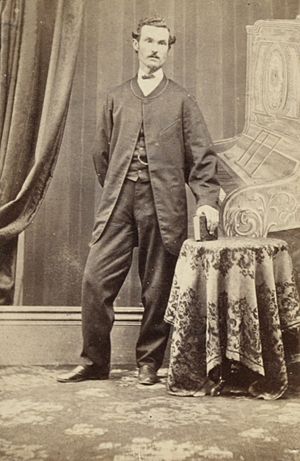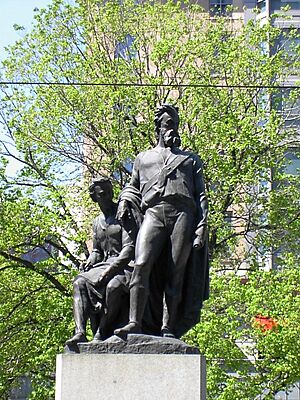John King (explorer) facts for kids
Quick facts for kids
John King
|
|
|---|---|

John King, circa 1861
|
|
| Born | 5 December 1838 |
| Died | 15 January 1872 (aged 33) St Kilda, Victoria, Australia
|
| Burial place | Melbourne General Cemetery |
| Nationality | Irish |
| Alma mater | Royal Hibernian Military School |
| Occupation | Soldier, camel handler, explorer |
| Known for | Survivor of the Burke and Wills expedition and first European to cross Australia from north to south |
John King (15 December 1838 – 15 January 1872) was an Irish-born British soldier who became a famous Australian explorer. He is best known as the only survivor of the four men who reached the Gulf of Carpentaria during the difficult Burke and Wills expedition. This expedition was the first to cross Australia from south to north. They found a path across the continent, starting from Melbourne in Victoria and ending at the Gulf of Carpentaria in Queensland.
Contents
John King's Early Life
John King was born in Moy, Ireland, on 15 December 1838. He was the youngest of six children.
He went to the Royal Hibernian Military School in Dublin from 1847 to 1853. At just 14 years old, he joined the 70th Regiment of Foot on 15 January 1853. King was then sent to Chatham in England. Later, his regiment was posted to India.
Time in India
King arrived in India in late 1853. His regiment was stationed in Cawnpore in the Northern Province. King worked as an assistant teacher at the Regimental School.
He was later moved to Peshawar and took part in important battles during the Indian Mutiny. King became very ill and spent 16 months recovering in the Rawalpindi District.
While recovering, he met George Landells. Landells was in India to buy 24 camels for exploring the Australian desert. King left the army in January 1860. He then traveled to Karachi and was hired by Landells. His job was to look after the Indian helpers who cared for the camels.
On 30 March 1860, Landells, King, two other Europeans, eight Indian helpers, and 24 camels sailed for Melbourne. They traveled aboard the ship Chinsurah.
Arriving in Australia
King arrived in Melbourne on 8 June 1860. The camels were brought ashore a week later. They were first kept at the stables of the Victorian Parliament House. Later, they moved to new stables at Royal Park. This was the starting point for the big expedition.
The Burke and Wills Expedition
Robert O'Hara Burke was chosen to lead the Victorian Exploring Expedition. Landells was his second-in-command. William John Wills was the surveyor and astronomer. John King was hired as one of the Expedition Assistants. He earned £120 a year.
The Journey Begins
The expedition left Melbourne on Monday, 20 August 1860. It included 19 men, 27 camels, and 23 horses. They reached Menindee on 16 October 1860. Here, Landells resigned after an argument with Burke. Wills was promoted to second-in-command. King was then put in charge of the camels.
Burke decided to split the expedition at Menindee. The main group reached Cooper Creek on 11 November 1860. They set up a supply depot there. The rest of the men were expected to follow from Menindee.
Push to the Gulf
After a short break, Burke decided to quickly push towards the Gulf of Carpentaria. He split the group again. On 16 December 1860, Burke, Wills, King, and Charley Gray left. They left William Brahe in charge of the depot at Cooper Creek.
On 9 February 1861, Burke, Wills, King, and Gray reached the mangroves. These were on the estuary of the Flinders River, near where Normanton is today. Heavy rains and swamps meant they never saw the open ocean.
The Difficult Return
The return journey was very hard. The men were already weak from hunger and exposure. Their progress was slow because of the tropical monsoon rains. Charley Gray died four days before they reached the depot at Cooper Creek. The other three men spent a day burying him.
They finally reached the depot on Sunday, 21 April 1861. To their dismay, the men from Menindee had not arrived. Brahe and the Depot Party had given up waiting and left just 9 hours earlier. Brahe had buried a note and some food under a tree. This tree is now famous as the Dig Tree.
Burke, Wills, and King tried to reach Mount Hopeless. This was the closest settled area in South Australia. However, they failed and returned to Cooper Creek. While waiting for rescue, Burke and Wills died from exhaustion and starvation. The exact date of their deaths is not certain, but it is thought to be 28 June 1861.
King's Survival and Rescue
King survived with the help of the Yandruwandha Indigenous people. He lived with them for two and a half months. He was rescued in September by Alfred William Howitt. Howitt buried Burke and Wills before returning to Melbourne.
Life After the Expedition
When Howitt reached Menindee, he sent King ahead to Melbourne. King was escorted by Edwin James Welch and Weston Phillips. King arrived back in Melbourne on 29 November 1861. He was seen as a hero and was surrounded by the excited people of Victoria.
King received a gold watch and a pension of £180 a year from the Royal Society of Victoria. King did not enjoy being famous. He was still physically and emotionally weak. He found it hard to deal with all the public interest.
His sister, Elizabeth, cared for King at her house in St Kilda. In 1863, he went to Tasmania to see if it would help him recover. He arrived in Hobart on 1 February.
King returned to Melbourne. He was present when the Burke & Wills statue was unveiled. This happened on the corner of Collins and Russell Streets in Melbourne on 21 April 1865. This date was the fourth anniversary of their return to Cooper Creek.
In 1865, he bought a house in Octavia Street, St Kilda. On 22 August 1871, he married his cousin, Mary Richmond. The wedding took place at the Wesley Church on Lonsdale Street.
King never fully recovered from the hardships he faced on the expedition. In 1869, his health started to get worse. In late 1871, he was so ill that his sister cared for him. He returned home to St Kilda and sadly died on 15 January 1872, at the age of 33. He died from a lung illness called tuberculosis. He is buried in the Melbourne General Cemetery.
John King was not related to another explorer named Stephen King. Stephen King was part of John McDouall Stuart's successful expedition in 1861–1862.


